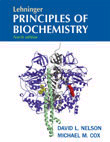1. The Foundations of Biochemistry
1.1 Cellular Foundations
1.2 Chemical Foundations
1.3 Physical Foundations
1.4 Genetic Foundations
1.5 Evolutionary Foundations
Distilled and reorganized from Chapters 1? of the previous
edition, this overview provides a refresher on the cellular,
chemical, physical, genetic, and evolutionary background to
biochemistry, while orienting students toward what is unique
about biochemistry.
PART I. STRUCTURE AND CATALYSIS
2. Water
2.1 Weak Interactions in Aqueous Systems
2.2 Ionization of Water, Weak Acids, and Weak Bases
2.3 Buffering against pH Changes in Biological Systems
2.4 Water as a Reactant
2.5 The Fitness of the Aqueous Environment for Living
Organisms
Includes new coverage of the concept of protein-bound water,
illustrated with molecular graphics.
3. Amino Acids, Peptides, and Proteins
3.1 Amino Acids
3.2 Peptides and Proteins
3.3 Working with Proteins
3.4 The Covalent Structure of Proteins
3.5 Protein Sequences and Evolution
Adds important new material on genomics and proteomics and
their implications for the study of protein structure, function,
and evolution.
4. The Three-Dimensional Structure of Proteins
4.1 Overview of Protein Structure
4.2 Protein Secondary Structure
4.3 Protein Tertiary and Quaternary Structures
4.4 Protein Denaturation and Folding
Adds a new box on scurvy.
5. Protein Function
5.1 Reversible Binding of a Protein to a Ligand: Oxygen-
Binding Proteins
5.2 Complementary Interactions between Proteins and Ligands:
The Immune System and Immunoglobulins
5.3 Protein Interactions Modulated by Chemical Energy:
Actin, Myosin, and Molecular Motors
Adds a new box on carbon monoxide poisoning
6. Enzymes
6.1 An Introduction to Enzymes
6.2 How Enzymes Work
6.3 Enzyme Kinetics as An Approach to Understanding Mechanism
6.4 Examples of Enzymatic Reactions
6.5 Regulatory Enzymes
Offers a revised presentation of the mechanism of
chymotrypsin (the first reaction mechanism in the book),
featuring a two-page figure that takes students through this
particular mechanism, while serving as a step-by-step guide to
interpreting any reaction mechanism
Features new coverage of the mechanism for lysozyme
including the controversial aspects of the mechanism and
currently favored resolution based on work published in 2001.
7. Carbohydrates and Glycobiology
7.1 Monosaccharides and Disaccharides
7.2 Polysaccharides
7.3 Glycoconjugates: Proteoglycans, Glycoproteins, and
Glycolipids
7.4 Carbohydrates as Informational Molecules: The Sugar Code
7.5 Working with Carbohydrates
Includes new section on polysaccharide conformations.
A striking new discussion of the "sugar code" looks at
polysaccharides as informational molecules, with detailed
discussions of lectins, selectins, and oligosaccharide-bearing
hormones.
Features new material on structural heteropolysaccharides
and proteoglycans
Covers recent techniques for carbohydrate analysis.
8. Nucleotides and Nucleic Acids
8.1 Some Basics
8.2 Nucleic Acid Structure
8.3 Nucleic Acid Chemistry
8.4 Other Functions of Nucleotides
9. DNA-Based Information Technologies
9.1 DNA Cloning: The Basics
9.2 From Genes to Genomes
9.3 From Genomes to Proteomes
9.4 Genome Alterations and New Products of Biotechnology
Introduces the human genome. Biochemical insights derived
from the human genome are integrated throughout the text.
Tracking the emergence of genomics and proteomics, this
chapter establishes DNA technology as a core topic and a path to
understanding metabolism, signaling, and other topics covered in
the middle chapters of this edition. Includes up-to-date
cover


